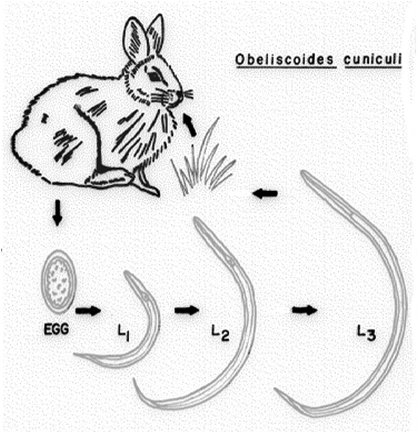Obesliscoides cuniculi
Esther van Praag, Ph.D.
|
MediRabbit.com is
funded solely by the generosity of donors. Every
donation, no matter what the size, is appreciated and will aid in the
continuing research of medical care and health of rabbits. Thank you |
|
This
parasite is cosmopolitan. It is commonly referred to as the rabbit stomach
worm. Two clearly defined subspecies have been identified and recognized as
infesting lagomorphs: • Obeliscoides
cuniculi multistriatus infecting
snowshoe hares (Lepus americanus), • Obeliscoides
cuniculi cuniculi infecting
mainly the eastern cottontail rabbits (Sylvilagus floridanus). Experimental crosses between Obeliscoides cuniculi cuniculi
males and Obeliscoides cuniculi multistriatus females have produced viable progeny
that exhibit mixed systemic characters. However, there is currently no
evidence to suggest that this phenomenon occurs in nature. The type host of Obeliscoides
cuniculi cuniculi is the pet rabbit, although
the other subspecies is also occasionally found. The life cycle of
Obeliscoides cuniculi is direct. Obeliscoides
sp. does not represent a public health risk.
Obeliscoides
cuniculi multistriatus
The eggs are approximately 96 by 46
micrometers in size and are excreted with the feces. The eggs generally have
a thin shell. The larvae develop inside the eggs and hatch after 30 to 36
hours. On the sixth day, the larvae reach the L3 stage, at which point they
become infective by penetrating the mucosa of the stomach. Within 24 hours,
the larva will exsheathe in the stomach and develop
into a mature adult. Adult parasites are pink and lack a
buccal capsule. These organisms are found in the mucus layer of the stomach.
The males, measuring 10–15 mm in length, possess well-developed lateral lobes
on the bursa copula, supported by rays and a pair of spicules. The female
specimens (15–18 mm) are distinguished by a pointed tail and a vulva located
in the caudal part of the body. The process of oviposition, or egg-laying,
typically begins 16 to 20 days after infection and continues for a period of
61 to 118 days.
Obeliscoides
cuniculi cuniculi
The eggs are slightly smaller than those
of the other subspecies: 83 by 47 micrometers. These eggs are excreted with
the feces at the 32-cell stage. The larva will undergo metamorphosis from the
L1 to the L3 stage on the sixth day. The larva demonstrates resistance to
temperatures ranging from –4 to 2°C; however, it is susceptible to
desiccation. After ingestion by the host, the L3
larvae will exsheat within one hour and start
invading the gastric mucosa. The final molt is likely initiated by the
migration of worms from the mucosa, which typically commences on day 5
following ingestion. This migration of worms can be observed directly on the
surface of the gastric mucosa. Clinical signs
The
presence of Obeliscoides cuniculi is
usually asymptomatic in rabbits. A severe infestation can lead to hemorrhagic
gastritis, accompanied by weight loss, anemia, anorexia, and diarrhea in
rabbits. This condition manifests during the first two weeks of infection,
after which the animals regain their normal condition. The presence of Obeliscoides cuniculi is diagnosed through
fecal flotation, which involves the identification of the parasite's eggs in
the subject's feces. During
the necropsy, it was noted that adult worms firmly adhere to the mucus
coating of the stomach, with some present in the gastric crypts as well. The
pathological signs are limited to the stomach, where a thickened and granular
("cobblestone") mucosa is observed. This is due to a combination of
larval parasites, glandular hyperplasia, and infiltration of inflammatory
cells. Treatment
Further Information
J.E. Alicata (1932) Life History
of the Rabbit Stomach Worm, Obeliscoides
cuniculi. J. Agricultural Res. 44: 401-419. D. Duwel, K. Brech (1981) Control
of Oxyuriasis in Rabbits with Fenbendazole. Lab. Anim. 15: 101-105. L.N. Measures, R.C Anderson (1983)
Development of the Stomach Worm, Obeliscoides cuniculi
(Graybill), in lagomorphs, woodchucks and small rodents. J. Wildl. Dis. 19:
225-233. L.N. Measures, R.C. Anderson
(1984) Hybridization of Obeliscoides
cuniculi (Graybill, 1923) Graybill, 1924 and Obeliscoides cuniculi multistriatus Measures and Anderson, 1983.
Proc. Helminthol. Soc. Washington 51: 179-186. S.W. Russel, B.C. Ward, N.F. Baker
(1970) Obeliscoides cuniculi:
Comparison of Gastric Lesions in Rabbits with those of Bovine Osteratogiosis.
Exp. Parasotol. 28:217-225. T.R. Schoeb (1990) Internal
Parasites of Rabbits, Dept. Comparative Medicine, University of Alabama,
https://netvet.wustl.edu/species/rabbits/rabparas.txt A.E. Sollod, T.J. Hayes, E.J.L. Soulsby (1968)
Parasitic Development of Obeliscoides
cuniculi in rabbits. J. Parasitol. 54: 129-132. |
e-mail: info@medirabbit.com





